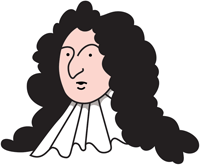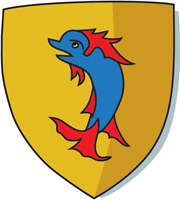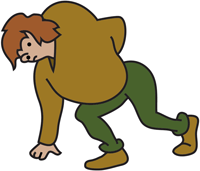< Introducing Paris
The History of Paris

Charles Martel – “the Hammer” – at the Battle of Poitiers in 732
Taking a trip through the history of France is rather like riding a white-knuckle roller coaster that hurtles from dizzy peaks of triumph down into the depths of defeat and despair. Although Paris has not always been the capital city, for most of the last 1,000 years it has been the unquestioned hub, and heart, of the country. Parisians have always been a feisty lot, keen to keep control of their city and fiercely proud of revolting against tyranny and injustice.
Astérix versus Caesar
In 250 BC a bunch of Astérix-style Celtic tribesmen, the Parisii, built a stockade on what is now the Ile de la Cité. The Parisii were smashed by Julius Caesar’s armies in 52 BC and the Romans occupied their city, naming it Lutetia, based on a Celtic word for a marshy place. The centre of the Roman city was where the Panthéon stands today.
Frankly brutal
As the Roman Empire crumbled, Paris was threatened by invading tribesmen from the east. First came Attila the Hun, then the Franks, who finally overthrew the Romans. In 481 their leader Clovis was crowned king, named his new domain Francia and made Paris his capital.
Then, in 732, the Arabs invaded France. The brilliant power behind the throne, Charles Martel, or “the Hammer”, lived up to his name by pounding their forces. His grandson, Charlemagne, was a towering figure who ruled over such vast swathes of Europe that, in 800, he was made Holy Roman Emperor by the Pope.
Medieval Paris
Throughout the Middle Ages, the powerful strategic position of Paris made it an important centre of commerce, politics and learning. The medieval church also played a crucial part, establishing the Left Bank as an intellectual powerhouse, with the first university in northern Europe, and constructing the cathedrals of St-Denis and Notre-Dame. However, the city was a stinky, overcrowded place. When Philippe-Auguste became king in 1165 he was so sickened by the stench from the window of his new Louvre fortress that he resolved to clean up the city. Open sewers were covered; marshlands were drained so the city could expand; and Paris was also wisely encircled by a huge, fortified defensive wall.
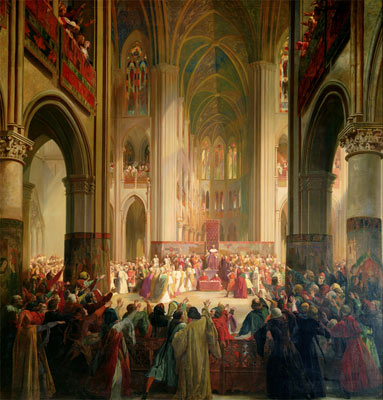
Meeting held in Notre-Dame in 1328, after the death of Charles the Fair
A long hundred years
By 1300 Paris was the biggest city in Europe, but it was a violent place that often rose up against the crown. In 1328 king Charles the Fair died leaving no direct heir. Both Edward III of England and Philippe de Valois had claims to the throne. So began the Hundred Years’ War (in fact a series of wars that lasted 116 years). Paris was a place of food shortages, rising taxes, marauding mercenaries, civil wars, plague and, in the bitter winter of 1407, icefloes drifting down the Seine.
Having defeated the French at Agincourt in 1415, the English took the city and held onto it until 1436.
Renaissance and rifts
By the time its occupiers left, Paris was in ruins but, during the reign of François I, the Louvre was transformed into a glittering palace and the city blossomed and grew under the influence of the Renaissance.
Then, in 1562, growing religious tensions led to the Wars of Religion, the low point of which was the St Bartholomew’s Day massacre of Parisian Protestants in 1572.
In 1589, the Protestant leader Henri of Navarre became heir to the throne but, to be accepted as King, he had to become a Catholic, joking “Paris is well worth a Mass”. Peace returned, Protestants were granted freedom of worship and “Good King Henri“ was a popular ruler. But he faced constant danger from extremists on both sides, and in 1610 was stabbed to death.
A whole lot of Louis
Henri’s eight-year-old son was crowned Louis XIII, but the power behind the throne was the ruthless Cardinal Richelieu. Taxes shot up, the peasants revolted and the nobles grumbled as their powers were curtailed. The next Louis, XIV, emptied the country’s coffers waging war and transforming Paris into a “new Rome“ fit for the Sun King.
His heir, Louis XV, was foolishly uninterested in France’s discontent, while Paris buzzed with the new ideas of the Enlightenment. Louis XVI, too, lacked the wits to rule a bankrupt country. The poor went hungry, and the middle class raged at having no say in how the country was run. Then the ruined harvest of 1788 led to food riots in Paris. France was ripe for revolution.
Power to the people!
In the summer of 1789, it all boiled over and the Bastille was stormed (see
Revolution!). Over the next few years, thousands of people were executed, among them Louis XVI. A young Corsican general, Napoleon Bonaparte, rallied the nation but, after waging war with the European powers, he lost his last battle at Waterloo in 1815 and the most tumultuous period in French history drew to a close.
Long live the king!
In 1815, the French decided to give the monarchy another chance and it was time for another Louis. Louis XVI’s elderly brother became King Louis XVIII. (Louis XVII never reigned – he died, aged ten, in prison.) He was succeeded by another brother, Charles X. Neither had learned the lessons of the Revolution and both tried to rule like absolute monarchs.
Unsurprisingly, the Parisians again revolted – the “July Revolution“ of 1830 – and Charles fled to England, to be replaced by another relative, the Duc d’Orléans, Louis-Philippe.
With a population of 900,000, Paris was the second largest city in Europe after London, but most people lived in disease-ridden slums. Grievances mounted and in February 1848 yet another revolution broke out. Louis-Philippe abdicated and fled, and a Second Republic was proclaimed. At the end of the year, presidential elections were held.
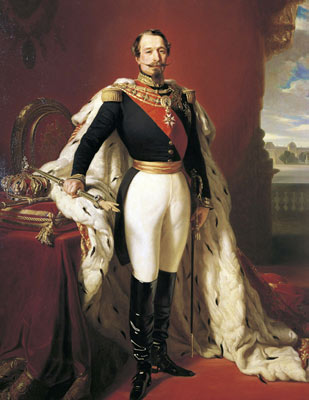
Portrait of French Emperor Louis-Napoleon Bonaparte, or Napoleon III
The Bonapartes are back
The victor, to the surprise of many, was Louis-Napoleon Bonaparte, the nephew of the late Emperor. He soon followed in his uncle’s footsteps by seizing dictatorial power in a coup d’état and proclaiming himself Emperor Napoleon III.
Under his rule, the appearance of Paris was transformed by Baron Haussmann, who replaced crowded, filthy, medieval streets with broad, intersecting avenues and boulevards. Parisians now had clean drinking-water, streetlighting and parks. The grand boulevards were soon filled with luxurious shops, but the city was still deeply divided. The poor were unable to afford the elegant new apartment buildings and were driven into the outlying districts, notably in the northeast of the city.
Fancy a rhino steak?
In 1870 Napoleon’s rule came to an abrupt end when he declared war on Prussia, only to see his armies smashed. He abdicated and the Third Republic was established. By September the Prussian army had laid siege to Paris. Poor Parisians had to dig up corpses to grind the bones into gruel, while the rich munched their way through the city’s zoos – rhino steaks went for a small fortune. Nonetheless, Parisians were furious when the government surrendered, and the city’s working-class militia refused to hand in their guns, instead taking over Paris as a revolutionary Commune. The government regrouped at Versailles and fierce fighting broke out as their troops retook the city. The Tuileries Palace and the town hall were destroyed and around 5,000 people were killed. In the aftermath, another 10,000 Communards were shot, 40,000 arrested and 5,000 deported.
But Paris soon bounced back. The metro, cars, telephones and cinemas transformed life in the capital, and the economy prospered thanks to France’s expanding empire. Paris became a glittering city, a mecca for artists, musicians and filmmakers.
The war to end all wars
In August 1914, war broke out across Europe. The Germans once more invaded France, and panic spread through Paris as the enemy army, just 30 km (19 miles) from Paris, could be seen from the top of the Eiffel Tower.
Miraculously, the city was saved. Over four years of war Parisians suffered terrible losses at the front, while at home there were food shortages and then a devastating influenza epidemic. But, by the 1920s, Paris was once again at the centre of artistic and literary life. France, however, was still divided and, when the Great Depression hit in 1929, extreme parties of both the right and the left flourished. The country’s political divisions were a major factor in leaving France unprepared for a second war, which began in September 1939.
The darkest hour
On 14 June 1940, Paris fell with virtually no resistance. The rightwing government of Marshal Pétain signed an armistice with the Nazis and moved south to Vichy, in central France, while a little-known general, Charles de Gaulle, called on the French from his base in London to continue the fight.
Paris suffered four years of Nazi occupation and, in May 1941, the Vichy-run police began deporting Parisian Jews to Auschwitz.
In June 1944 the Allies landed in Normandy, and in August an uprising broke out in Paris, with barricades and running battles in the streets. On 26 August, de Gaulle entered the city to a rapturous welcome, and established a temporary government that lasted until 1946, when the Fourth Republic was established.
All change
Reconstruction was hard; there were ongoing divisions between left and right, and colonial conflicts in Indo-China and Algeria brought bloodshed to the streets of Paris. In 1958 the Fourth Republic collapsed and De Gaulle was returned to power. By 1968, growing social unrest and De Gaulle’s authoritarian style of government sparked an uprising led by students and factory workers.
In the 1970s, under presidents Georges Pompidou and Valéry Giscard d’Estaing, Paris was again transformed. Modernism was all the rage, and the Pompidou Centre and Tour Montparnasse became new Parisian landmarks. In the 1980s, President Mitterrand gave the Louvre its glass pyramid and built a futuristic new district, La Défense.
In 1994 the Eurostar train service linked Paris direct to London via the Channel Tunnel. In 2002, France adopted the single-currency Euro to replace the Franc.
New challenges
François Hollande defeated Nicolas Sarkozy in the presidential elections in May 2012, to become the second Socialist Party president of the Fifth French Republic, after Mitterand. But his policies are yet to lead to the level of reforms which many had hoped for.
Heroes & Villains
Witty and wise
Voltaire (1694–1778), one of the most famous figures of the Enlightenment, often got in trouble with the authorities because of his beliefs and writings, and even had to leave Paris at times. He supported freedom of speech, religious tolerance and the rights of the common man against priests and royals. He was also known for his witty plays and essays.
Go girl!
St Geneviève was a nun, and just a slip of a girl, but she was a match for Attila the Hun. Her prayers are credited with having stopped Attila’s Huns from invading Paris in 450. She was named patron saint of Paris as a result.
The power & the glory
Cardinal Richelieu was a ruthless Catholic bishop and the power behind the throne under Louis XIII. He is portrayed as a villain in the book The Three Musketeers. That trio were soldiers loyal to Louis XIII, who resisted Richelieu’s devious plans to control king and country.
Louis XIV let himself be known as the Sun King because he wanted everyone to think that the world revolved around him. He built a vast palace at Versailles, and cost his country a fortune waging war.
A man in a million
Napoleon Bonaparte, one of the most important characters in European history, managed to get France back on its feet again after the Revolution, but his ambitions for glory eventually brought him down.
Facts & figures
What’s in a name?
France gets its name from a fierce tribe of warriors, the Franks, who lived in northwestern Europe after the collapse of the Roman Empire. France means “land of the Franks”.
Dauphin means “dolphin” in French. For centuries, the heir to the throne was known as the Dauphin.
Neuf may be the French word for “nine”, but the Pont Neuf is not the ninth bridge in Paris. In fact, it was the first stone bridge ever built in the city. Henri IV called it the New Bridge when opened in 1607, and the name stuck, even though it is now the oldest bridge in town.
Fable fact file
In the 18th and 19th centuries, French poetry and literature flourished. Some of the most famous tales were penned by acclaimed French writers during this period, among them Cinderella, Sleeping Beauty, The Three Musketeers, The Count of Monte Cristo, The Hunchback of Notre-Dame, Twenty Thousand Leagues Under the Sea and The Phantom of the Opera.
Is Paris burning?
Adolf Hitler was determined that Paris should not fall to his enemies except in ruins, but his plans were thwarted by his general, Dietrich von Choltitz, who was the military governor of Paris in August 1944. Unable to bear the thought of such pointless destruction, von Choltitz ignored several direct orders to detonate the explosives packed throughout the city – even, legend has it, a hysterical phone call from the Führer himself, demanding “Is Paris burning?”





